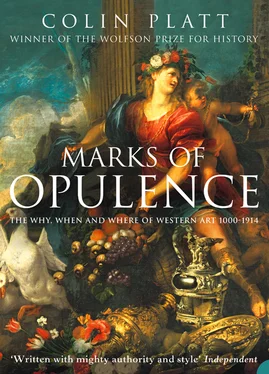1 ...8 9 10 12 13 14 ...22 It came about by the treacherous advice of the said Hugh that carved work, unnecessary, trifling, and beyond measure costly, was added; and before the middle of the work had risen as high as the water-table, the abbot was tired of it and began to weary and to be alarmed, and the work languished. And as the walls were left uncovered during the rainy season the stones, which were very soft, broke into little bits, and the wall, like the fallen and ruinous stonework, with its columns, bases and capitals, slipped and fell by its own weight; so that the wreck of images and flowers was a cause of smiles and laughter to those that saw it. 21
The schadenfreude of John de Cella’s critics would certainly have been shared by Abbot Samson of Bury (1182–1211), in whom even his biographer saw something of the night. Abbot Samson, Jocelin of Brakelond tells us, ‘was a serious-minded man and was never idle … [But] as the wise man [Horace] said, no one “is entirely perfect” – and neither was Abbot Samson.’ Always more manager than spiritual father of his community, Samson ‘appeared to prefer the active to the contemplative life, in that he praised good obedientiaries (office-holders) more highly than good cloister monks, and rarely commended anyone solely for his knowledge of literature unless he also knew about secular matters.’ 22 Those secular matters, to Abbot Samson’s mind, included the keeping of meticulous accounts. And the highly professional accounting practices of which Abbot Samson and his generation were the undoubted pioneers, helped extract the maximum profit from the land. Soon after his election, it was on Abbot Samson’s command that
A complete survey was made, in each hundred, of letes, suits, hidages, foddercorn, renders of hens, and other customs, rents, and payments, which had always been largely concealed by the tenants. Everything was written down, so that within four years of his election, no one could cheat him of a penny of the abbacy rents, and this despite the fact that no documents relating to the administration of the abbey had been handed on to him from his predecessors … This was the book he called his ‘Kalendar’. It also contained details of every debt he had paid off. He looked in this book nearly every day, as though it were a mirror reflecting his own integrity. 23
It was under Abbot Samson’s sharp-eyed management that the great court at Bury echoed once again ‘to the sound of pickaxes and stonemasons’ tools’. And effective financial controls, from that time forward, would greatly ease the lot of the rebuilders. When Canterbury Cathedral’s choir was rebuilt after the fire of 1174, it owed at least some of its new glory to pilgrims’ offerings at the shrine of Archbishop Thomas Becket, murdered there just four years before. However, the greater part of the required funding, both of this and later works, was always less piety-driven than rental-led. While frequently in debt to Sienese bankers among others, the cathedral’s monk-custodians – the third richest monastic community (after Westminster and Glastonbury) in the kingdom – never stopped building at any time. 24
Canterbury’s monks could handle debt more securely, and over a much longer term, because they were able to calculate very exactly what was owing to them. One of the cathedral-priory’s earliest rentals, dating to about 1200, brings together in one place all the information its obedientiaries might need for the resolution of future disputes. Not only, that is, did it record the names, rents, and payment-dates of the priory’s Canterbury tenants, but it gave locations and measurements also, beginning with the Northgate tenement of Roger fitzHamel’s sister, who paid sixpence at Michaelmas for ‘land lying behind our almonry wall; its breadth to the north 26 feet, length from the street towards the west 110 feet’. 25 Nobody until that time had kept records of such precision. Yet so fast-developing was the economy, and so urgent was the need for new mechanisms of control, that within less than a generation of those first monastic rentals, almost every major landowner would keep the same.
It is the survival of such records that makes possible for the first time convincing estimates of growth in this century. Thus the estates of Christ Church Canterbury are thought to have almost doubled their net worth through the long thirteenth century; Westminster Abbey’s assets grew by more than twice in the same period; the monks of Battle and the bishops of Ely nearly trebled their receipts; and the income of the bishops of Worcester rose by four. 26 Even allowing for inflation, such levels of growth are exceptional. And while it was the grander projects of the already rich which inevitably attracted the first funding, some residue trickled down to the localities. In the majority of English parishes, the rector was also a major landowner. And in clear recognition of the continuing affluence of his class, the chancels of many parish churches – widely acknowledged by that date to be the rector’s personal charge – were rebuilt on the most generous of scales. Not only were the new chancels of late thirteenth- and early fourteenth-century England much larger than before, they were also conspicuously better furnished – with canopied piscina, triple sedilia and priest’s door in the south wall; carved reredos behind the altar; founder’s tomb and Easter Sepulchre to the north. In the post-Plague recession after 1349, such rectorial investment fell off sharply. And when, after a gap of half a century or more, building began again in many parishes, it was the parishioners’ nave rather than the rector’s chancel which claimed the rebuilders’ first attention, dread of Purgatory (not surplus wealth) being the spur. 27
There was little, however, even just before the plague, to stop the rich growing exponentially richer. For while it is probably true that population growth was slowing before 1300, and although serious subsistence crises may already have developed as early as the 1260s in some regions, it was never the rich who paid the price. 28 As the supply of labour went on growing, its cost fell still further; as the demand for land rose, so rents rose also; as husbandry intensified on overcrowded plots, tithable yields continued to increase. Some have seen Europe’s widespread famines of 1315–17 as the critical divide, when population advance turned into a retreat. And for Jacques Le Goff, ‘the combination of poor technological equipment and a social structure which paralysed economic growth meant that the medieval West was a world on the brink … constantly threatened by the risk that its subsistence might become uncertain … only just in a state of equilibrium’. 29 But try telling that to a Sienese banker or to some wealthy prelate from the North. And many historians now take the view that it was the onset of the Black Death in 1347–9 – not overcrowding nor soil exhaustion, not a deteriorating climate nor a commerce-averse Church – which ended medieval Europe’s golden age. ‘France’, concludes James Goldsmith, ‘did not face a serious economic or demographic crisis in the half-century prior to the Black Death. France was not trapped in a Malthusian-Ricardian dilemma in which population increase outstripped food production. France was not overpopulated in terms of its economic structures and there was no shortage of land.’ 30 In practice, every circumstance still combined in the last half-century before the Pestilence to deliver yet more riches to the fortunate.
In the meantime, many had come to take prosperity for granted. There was never a time, for example, when skilled craftsmen lacked employment on the increasingly ambitious building programmes – three churches in two centuries – of the wealthy canons of Guisborough, in northern Yorkshire. Masons settled permanently in Guisborough township, they raised families to succeed them, were buried in the church’s shadow and left money to the priory’s fabric-fund in their wills. 31 And while religious communities of every allegiance, confident in their rent-rolls, frequently took on greater projects than was prudent, very few came to grief as a result. Other wealthy Yorkshire houses where new construction never stopped included the near-neighbours, Cluniac Pontefract and Benedictine Selby. Both had contracted huge building debts before the end of the thirteenth century, as had the normally affluent canons of Augustinian Dunstable, forced to cut their commons to make ends meet:
Читать дальше












